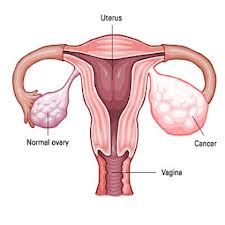ABOUT THE DISEASE
Ovarian cancer is a malignant / cancerous tumor - abnormal growth of tissue that develops in ovaries. Ovaries are the reproductive organs that produce a woman`s eggs. Ovarian cancer is the fifth leading cause of cancer death among women.

SYMPTOMS
There may be no or quite vague symptoms initially. Some of the following symptoms may be associated with this disease:
- • Bloating or swelling in the belly area.
- • Abnormal menstrual cycle.
- • Lack of appetite.
- • Sudden loss or gain of weight.
- • Pain during sex.
- • Pain and pressure in the back and pelvis.
- • Indigestion, increased gas and bloating.
- • Abnormal vaginal bleeding.
DIAGNOSIS
- Physical examination, including a pelvic examination
- Pelvic ultrasound/CT/MRI
- CA-125, Blood chemistry
- Pelvic laparoscopy followed by a biopsy
CAUSES
There are no known causes of ovarian cancer. However, below are some of the risk factors for ovarian cancer:
• Age - more prevalent in women above the age of 50.
• Personal or family history of endometrial, colon, or breast cancer and a family history of ovarian cancer.
• Women with the BRCA 1 and BRCA 2 genes are at a very high risk of getting ovarian cancer.
• The use of fertility medications may increase the risk of getting ovarian cancer.
• Late menopause (after age 50).
• Women with no pregnancies
TREATMENT METHODS
The treatment plan includes a surgery to remove the diseased tissue followed by chemotherapy. Depending on the stage and grade of cancer, it can be:
• Oopherectomy - A surgery where one or both of the ovaries are removed.
• Total abdominal hysterectomy- This surgery removes both ovaries, the Fallopian tubes, the uterus and nearby lymph glands.
• Chemotherapy may be used after surgery to prevent the cancer from spreading. Radiation therapy may also be given.
You may also like to learn about:
Cancer Endometrium
Menopause
Ovarian cysts
Cervical cancer
Polycystic ovarian disease
Dyspareunia